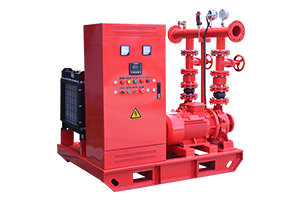Are there guidelines for winterizing fire pumps in cold climates?
Dec 22, 2023
Share:
Yes, winterizing fire pumps in cold climates is crucial to ensure their proper functioning during freezing temperatures. Here are some general guidelines for winterizing fire pumps:
1. **Insulate and Heat:**
- Insulate the pump house or pump room to help retain heat.
- Install heat trace tape on pipes and other vulnerable components to prevent freezing.
2. **Keep the Pump House Warm:**
- Maintain a minimum temperature inside the pump house or pump room to prevent freezing. This temperature may vary, but it is often recommended to keep it above freezing.
3. **Drain the System:**
- Drain the entire fire protection system, including pipes, hoses, and pump casing, to prevent water from freezing and causing damage.
4. **Use Antifreeze:**
- Add antifreeze to the fire protection system. This is especially important for systems that cannot be completely drained. Use an antifreeze solution appropriate for fire protection systems.
5. **Inspect and Maintain Heaters:**
- Regularly inspect and maintain any heating equipment in the pump house, such as electric heaters or space heaters.
6. **Check Insulation:**
- Inspect insulation regularly to ensure it is intact and effective. Replace any damaged insulation promptly.
7. **Test the Pump:**
- Regularly test the pump to ensure it starts and operates correctly during cold weather. This can help identify and address any issues before they become serious.
8. **Monitor Weather Conditions:**
- Stay informed about weather conditions and forecasts. Take additional precautions during extreme cold spells.
9. **Install Pump Enclosures:**
- Consider installing pump enclosures or shelters that provide additional protection against cold weather.
10. **Emergency Procedures:**
- Establish emergency procedures in case the fire pump fails during winter. This may include having backup pumps, alternative water sources, or procedures for dealing with frozen components.
11. **Train Personnel:**
- Ensure that personnel responsible for the fire protection system are trained on winterizing procedures and emergency response protocols.
12. **Documentation:**
- Keep thorough documentation of winterizing procedures, including dates of maintenance, inspections, and any issues identified and addressed.
Always refer to the manufacturer's guidelines and recommendations for specific instructions related to winterizing fire pumps, as different pumps may have unique requirements. Additionally, compliance with local fire codes and regulations is essential. Consulting with a fire protection professional or engineer is advisable to ensure that your fire pump is properly winterized for your specific location and conditions.

1. **Insulate and Heat:**
- Insulate the pump house or pump room to help retain heat.
- Install heat trace tape on pipes and other vulnerable components to prevent freezing.
2. **Keep the Pump House Warm:**
- Maintain a minimum temperature inside the pump house or pump room to prevent freezing. This temperature may vary, but it is often recommended to keep it above freezing.
3. **Drain the System:**
- Drain the entire fire protection system, including pipes, hoses, and pump casing, to prevent water from freezing and causing damage.
4. **Use Antifreeze:**
- Add antifreeze to the fire protection system. This is especially important for systems that cannot be completely drained. Use an antifreeze solution appropriate for fire protection systems.
5. **Inspect and Maintain Heaters:**
- Regularly inspect and maintain any heating equipment in the pump house, such as electric heaters or space heaters.
6. **Check Insulation:**
- Inspect insulation regularly to ensure it is intact and effective. Replace any damaged insulation promptly.
7. **Test the Pump:**
- Regularly test the pump to ensure it starts and operates correctly during cold weather. This can help identify and address any issues before they become serious.
8. **Monitor Weather Conditions:**
- Stay informed about weather conditions and forecasts. Take additional precautions during extreme cold spells.
9. **Install Pump Enclosures:**
- Consider installing pump enclosures or shelters that provide additional protection against cold weather.
10. **Emergency Procedures:**
- Establish emergency procedures in case the fire pump fails during winter. This may include having backup pumps, alternative water sources, or procedures for dealing with frozen components.
11. **Train Personnel:**
- Ensure that personnel responsible for the fire protection system are trained on winterizing procedures and emergency response protocols.
12. **Documentation:**
- Keep thorough documentation of winterizing procedures, including dates of maintenance, inspections, and any issues identified and addressed.
Always refer to the manufacturer's guidelines and recommendations for specific instructions related to winterizing fire pumps, as different pumps may have unique requirements. Additionally, compliance with local fire codes and regulations is essential. Consulting with a fire protection professional or engineer is advisable to ensure that your fire pump is properly winterized for your specific location and conditions.







